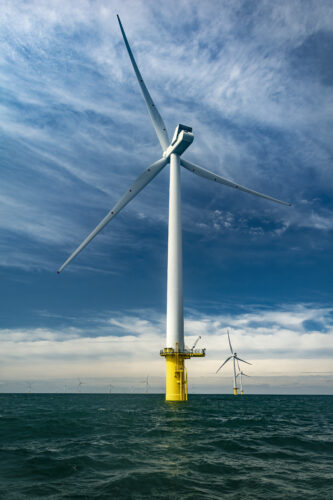
With the U.S.’ first offshore wind farm up and spinning off Block Island, Rhode Island, and many more in various stages of development, regulators, scientists, and industry leaders are hot on the heels of conservation and management off the East Coast. How do we embrace this alternative energy technology while also protecting marine animals from any potential impacts that this new technology may bring to the Atlantic Outer Continental Shelf (OCS)? This was the main question on the minds of all who attended the Bureau of Ocean Energy Management’s (BOEM) Best Management Practices Workshop for Atlantic Offshore Wind Facilities and Marine Protected Species during March 7-9 at NOAA Fisheries headquarters in Silver Spring, Maryland.
BOEM assembled an expert panel to identify and discuss best management practices (BMPs) for preventing, reducing, and monitoring offshore wind impacts to marine protected species on the Atlantic OCS. Panelists included scientists, managers, and policy experts from nonprofit organizations, universities, and U.S. federal agencies. The offshore wind industry was also represented via environmental permitting specialists and managers from US Wind, Deepwater Wind, and DONG Energy Wind Power AS. In addition, several panelists and speakers, including representatives from the Joint Nature Conservation Committee in the UK and the European energy company Vattenfall Wind, provided unique insights into the lessons learned from international offshore wind programs, many of which have been operational for decades.
Initial presentations on past and current baseline monitoring efforts help set the stage for the workshop discussions. Protection of the critically endangered North Atlantic right whale was, of course, a key topic for most discussions, particularly in regards to cumulative impacts. Addressing cumulative impacts involves in-depth studies and analyses which require extensive spatial and temporal data on a variety of sources of potential impact, such as shipping traffic, military operations, and seismic surveys, that occur in and near a project area. Because these data often do not exist, quantitative analyses are limited and often cannot be conducted to accurately estimate cumulative impacts. Therefore, stakeholders often rely on qualitative assessments to describe potential cumulative impacts which can provide some insight but may not be enough to develop plans to adequately protect species like the North Atlantic right whale, which is sensitive to a wide range of anthropogenic activities.
Additional topics discussed during this workshop included High-Resolution Geophysical (HRG) surveys, pile driving, vessel traffic, and baseline monitoring. The panel provided considerations and recommendations for specific BMPs for each of these topic areas. For example, several panelists agreed that general BMPs should be set for all developers to use during HRG surveys, while specific BMPs could be set for certain areas and times of year, such as when right whales are present. However, the development of any seasonal restrictions would need to also account for the fact that these restrictions would likely extend the construction period into additional years which would extend the period of exposure of these activities to marine life. Therefore, managers would need to weigh the pros and cons of seasonal BMPs. Regardless, there appears to be a need for a BMP framework that includes simple yet effective monitoring and mitigation protocols that can also be flexible and altered for specific sites and projects when necessary.
BOEM plans to extend these discussions on BMPs to a second workshop which has yet to be announced. For now, managers can continue to use the BMPs included in BOEM’s 2007 Final Programmatic Environmental Impact Statement for Alternative Energy Development and Production and Alternate Use of Facilities on the Outer Continental Shelf as minimal mitigation measures to be applied to energy development projects. In addition, for acoustic measures, managers can refer to NOAA’s final report (July 2016) on Technical Guidance for Assessing the Effects of Anthropogenic Sound on Marine Mammal Hearing. This document provides acoustic thresholds for onset of permanent threshold shift (PTS) and temporary threshold shifts (TTS) in marine mammal hearing for all sound sources. During the workshop, Amy Scholik-Schlomer (NMFS Protected Resources Acoustic Coordinator) presented a brief overview of NOAA’s acoustic technical guidance and the companion User Spreadsheet which NMFS developed as a tool to help those who need to determine isopleths for PTS onset associated with their activities but who are not capable of modeling exposure levels on their own. With this Excel tool, users can combine their noise source information (e.g., estimated source levels and duration) with NMFS’ simple weighting factor adjustments to obtain estimated isopleths for various hearing groups (e.g., low-frequency and high-frequency cetacean groups).
For more information about the workshop, refer to the workshop website which includes links to the presentations within the agendas for each day of the workshop. A final workshop report is not yet available but will be posted here.


